
The Great Central Railway (GCR) is a heritage railway in Leicestershire, England, named after the company that originally built this stretch of railway. It runs for 8.25 miles (13.28 km) between the town of Loughborough and a new terminus in the north of Leicester. It has period signalling, locomotives and rolling stock.

Tilehurst railway station serves the suburb and former village of Tilehurst, west of Reading, Berkshire, England. The station is on the extreme northern edge of Tilehurst and at a much lower level than most of that suburb. The railway line and station occupy a strip of land between the A329 road and the River Thames, with the up relief platform on an embankment above the river bank.
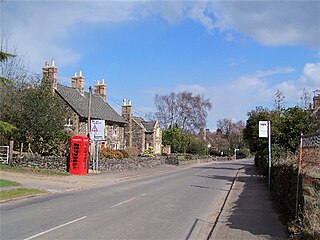
Swithland is a linear village in the Charnwood borough of Leicestershire, England. The civil parish population was put at 230 in 2004 and 217 in the 2011 census. It is in the old Charnwood Forest, between Cropston, Woodhouse and Woodhouse Eaves. It has a village hall, a parish church and a public house, the Griffin Inn. The village is known for the slate that was quarried in the area.

Leicester Central was a railway station in Leicester, England. It was situated to the west of the city centre, on Great Central Street which is today just off the inner ring road. It was closed in 1969.

Nottingham Victoria railway station was a Great Central Railway and Great Northern Railway railway station in Nottingham, England. It was designed by the architect Albert Edward Lambert, who also designed the rebuild of the Nottingham Midland station.

Ruddington is a disused railway station on the Great Central Main Line south of Nottingham. The line had branches that ran to the now decommissioned Ruddington Depot.
There are 22 disused railway stations on the Bristol to Exeter line between Bristol Temple Meads and Exeter St Davids. The line was completed in 1844 at which time the temporary terminus at Beambridge was closed. The most recent closure was Tiverton Junction which was replaced by a new station} on a different site in 1986. 12 of the disused stations have structures that can still be seen from passing trains.
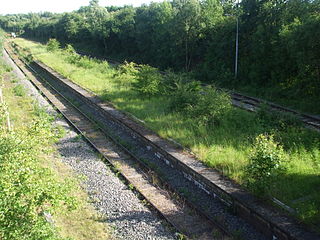
Calvert was a railway station at Calvert, Buckinghamshire on the former Great Central Main Line between Manchester Piccadilly and London Marylebone. The station was opened in 1899 and closed to passengers in 1963 and goods in 1964.

Rothley railway station is a heritage railway station on the preserved section of the Great Central Railway's London Extension. Built to the standard island platform pattern of country stations on the line, it originally opened on 15 March 1899 and has been restored to late Edwardian era condition, circa 1910.
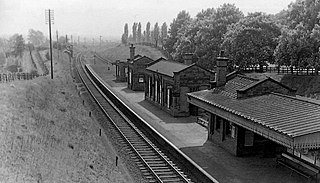
Belgrave and Birstall railway station was a railway station opened by the Great Central Railway in 1899. It served the villages of Belgrave and Birstall in Leicestershire. It closed in 1963.

Nottingham Arkwright Street was a railway station in Nottingham on the former Great Central Main Line which ran from Manchester Piccadilly to London Marylebone. The station opened with the line in 1899 and closed in 1963 as part of rationalisation; it reopened four years later upon the closure of Nottingham Victoria railway station, only to close in 1969.

Swithland Reservoir is a reservoir in the English county of Leicestershire. It is north-east of the village of Swithland from which it takes its name, north-west of Rothley and approximately 133 metres (145 yd) south-west of Mountsorrel Quarry. It is part of the 187.1-hectare (462-acre) Buddon Wood and Swithland Reservoir Site of Special Scientific Interest (SSSI).
Swithland Sidings is a set of railway sidings on the preserved Great Central Railway, situated just south of Swithland Reservoir and Swithland Viaduct which crosses it.

Woodford Halse railway station stood on the Great Central Railway (GCR) main line, the last main line to be built from the north of England to London. The station opened with the line on 15 March 1899 under the name Woodford and Hinton and served the adjacent villages of Woodford Halse to the east and Hinton to the west, both in Northamptonshire. The station was renamed Woodford Halse on 1 November 1948.

Ashby Magna was a station on the Great Central Railway, the last main line to be constructed from the north of England to London, which opened in 1899 to serve the Leicestershire village of Ashby Magna.

Carrington railway station was a railway station in Nottingham on the Great Central Railway main line, the last main line to be built from the north of England to London. The station opened with the line on 15 March 1899, and served the Nottingham suburb of Carrington until 1928.
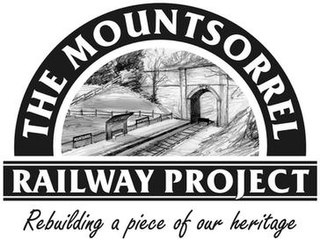
The Mountsorrel Railway was a network of industrial railway lines that served the granite quarries which dominate the Leicestershire village of Mountsorrel. After being closed in the 1950s, a section was reopened in 2015 as a heritage line run by the Mountsorrel & Rothley Community Heritage Centre.
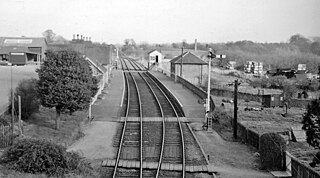
Brackley Town was a railway station which served the Northamptonshire town of Brackley in England. It opened in 1850 as part of the Buckinghamshire Railway's branch line to Verney Junction which provided connections to Banbury, Bletchley and Oxford and closed in 1963.
Gotham Sidings, was a set of railway sidings on the Great Central Main Line, where the line crosses Gotham Moor near Gotham, Nottinghamshire. The sidings were set between Rushcliffe Halt and Ruddington railway station.
The Great Central Railway (Nottingham) (formerly known as the Nottingham Heritage Railway) is a heritage railway located at the Nottingham Transport Heritage Centre (NTHC), on the south side of the village of Ruddington, in Nottinghamshire. The route consists of almost 10 miles (16 km) of the former Great Central Main Line from Loughborough South Junction (with the Midland Main Line) to Fifty Steps Bridge and the site of Ruddington's former GCR station, plus a branch line from Fifty Steps Bridge to Ruddington Fields station which is located on a former Ministry of Defence site next to Rushcliffe Country Park.















